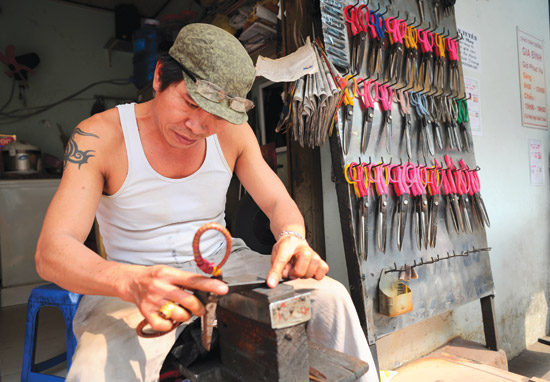(No.1, Vol.4, Jan-Feb 2014 Vietnam Heritage Magazine)
Photo: Pham Duc Long
Photo: Tran Nguyen Anh
The days before Tet (the lunar New Year) is the earning season for those who sell and sharpen knives in Ho Chi Minh City. The knife business is bustling on roadsides and in the markets.
Ms Loan at Hoa Hung market said that she always prepares for Tet with a few new knives. ‘Everything goes smoothly if the knives are sharp. Otherwise the whole year will be a mess’. She added that, for those women who have so much to do in the kitchen this time of the year, ‘Heavy blunt knives can’t chop. Light blunt ones are even worse.’
Ms Loan said that she often buys knives made by a traditional blacksmith, but most people now only use factory-made knives, sold in the supermarkets. The knives in the supermarkets may cost from a few hundred thousand to a few million dongs, but the ones made by blacksmiths cost only around thirty thousand dongs a piece.
Trieu Quang Phuc Street in District 5 is a whetting street. Phong, a whetter with over 10 years of experience, said, ‘There are about 30 shops here, four of which belong to Vietnamese households, the rest are Chinese.’ Every Tet, people bring whole sets of knives and scissors for us to sharpen. Good knives can last long if whetted properly. ‘Whetting a knife costs from ten to fifty thousand.’ Phong’s whetstone was ordered from the US. During this busy time, the customers may have to wait a day or two to get their knives back. The betel nut-cutting or morning glory-splitting knives are tiny, while the medicine and bone-chopping ones are big. Each household has a set of five to seven pieces. ‘Each kind of knife requires a different whetting technique, or you may destroy them,’ Phong said.
Beside the knife street, there are also mobile whetters. Mr Lam Binh, a disabled man, moves around markets to earn his living. His price is cheap-as low as three thousand. He said, ‘The industry-made knives from the supermarkets are very hard and can only be machine-ground.’ He has a gas-fuelled motor attached to the back of his motorcycle for this purpose. ‘In this season, I do a hundred knives a day. That’s some money to send to my wife and kids.’ Mr Binh comes from Quang Ngai, South Central Vietnam. He’s been working away from home for years. Many whetters from his village, often relatives, move to the city to whet and earn a living.
Mr Binh said, ‘Whetters come more and more each day. To avoid conflict, we sometimes have to move away from usual places.’ He used to whet in Hoa Hung market, but now he moves around, stopping here and there just for a while.
As Tet approaches, whetters from the provinces pour into the city. Thong, a knife master from the Mekong Delta, also joined the army of tramping whetters. He said, ‘I brought with me good knives for clearing the jungle; each is worth over four hundred thousand, but nobody buys them here.’ Thong also said that sometimes pugnacious kids asked him for machetes and swords. ‘We come here to earn only when there is no farming work, before New Year. We really don’t know where those weapons are being sold.’
All the whetters think that the traditional knives are better than the factory- made ones.
Phong said, ‘Many industrial knives that flood the market imitate Japanese goods. But while the Japanese knives are sharp and durable, these ones quickly get blunt, yet are hard to whet!’ However, a set of real Japanese knives costs over ten million, so most of people still use the fakes.
Mr Lam Binh thinks that factory-made knives are tempered whole, so they are hard. The traditional blacksmiths only temper the sharp edge. When the knife goes dull, they heat it and whet it again.
The whetters also complain that the old-fashioned knives have good steel, but ‘they are poor in design and the handle is often loose.’ Nowadays, only the big knives for bone chopping, made in the traditional way, prevail in the market. Mr Lam Binh still prefers the Vietnamese knives, because they are made by Vietnamese. He sighs, ‘These days, eight out of ten knives I whet are foreign made.’

